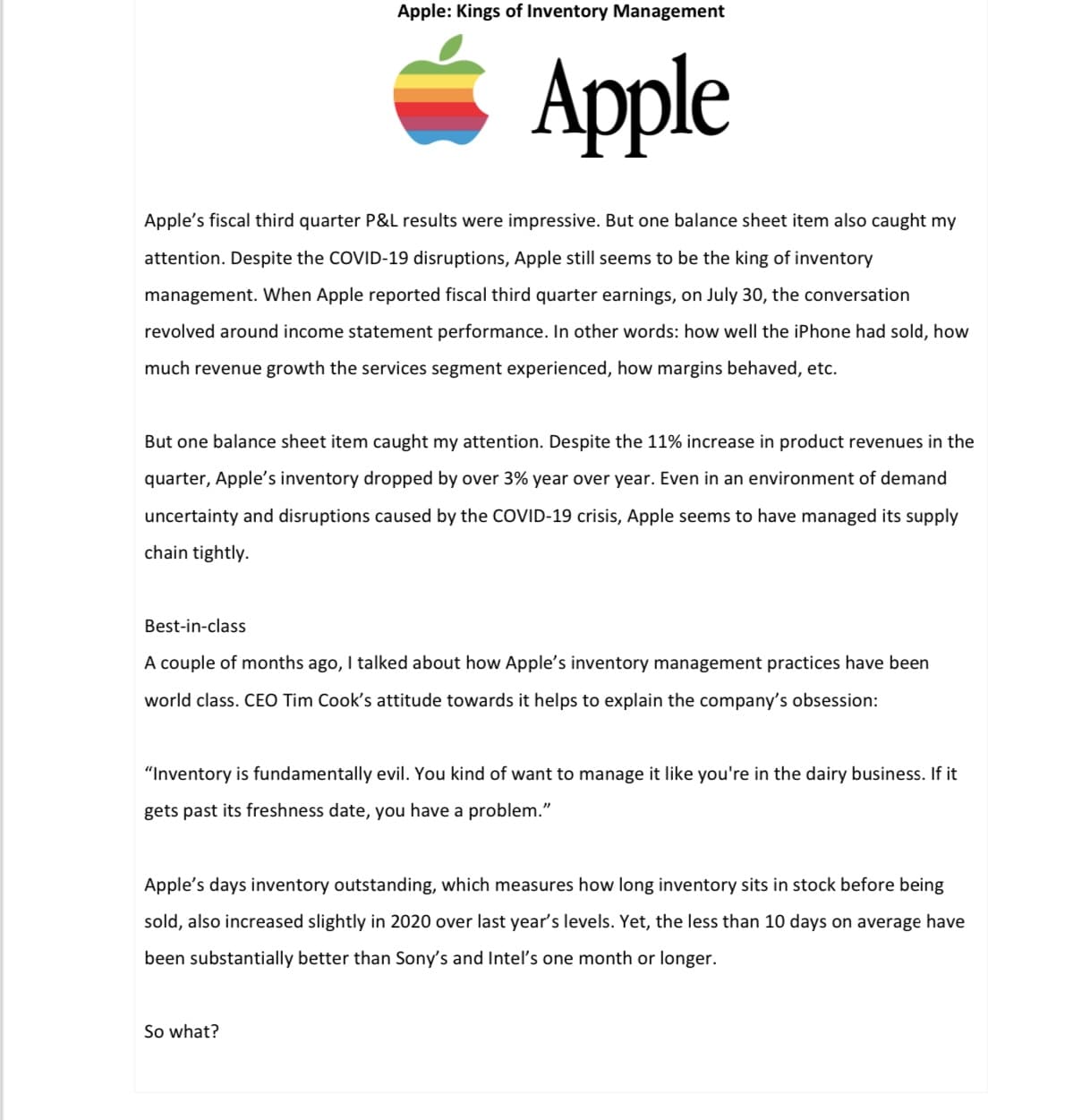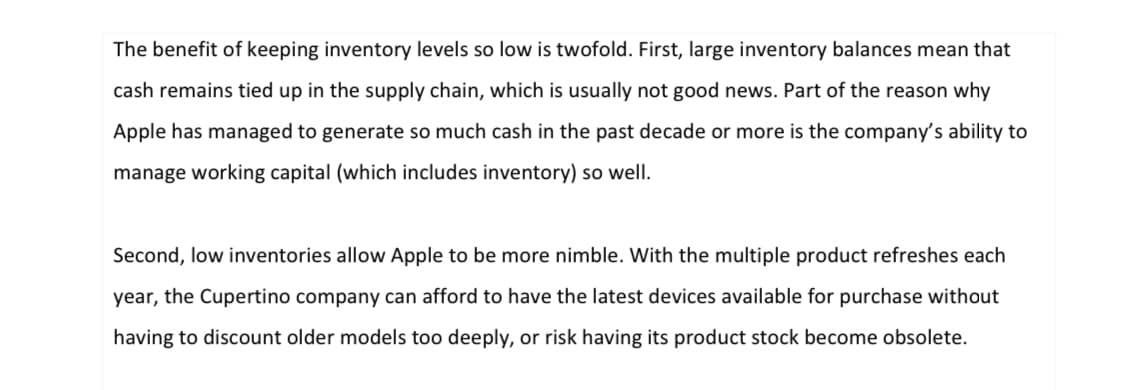ple: Kings Apple Apple's fiscal third quarter P&L results were impressive. But one balance sheet item also caught my attention. Despite the COVID-19 disruptions, Apple still seems to be the king of inventory management. When Apple reported fiscal third quarter earnings, on July 30, the conversation revolved around income statement performance. In other words: how well the iPhone had sold, how much revenue growth the services segment experienced, how margins behaved, etc. But one balance sheet item caught my attention. Despite the 11% increase in product revenues in the quarter, Apple's inventory dropped by over 3% year over year. Even in an environment of demand uncertainty and disruptions caused by the COVID-19 crisis, Apple seems to have managed its supply chain tightly. Best-in-class A couple of months ago, I talked about how Apple's inventory management practices have been world class. CEO Tim Cook's attitude towards it helps to explain the company's obsession: "Inventory is fundamentally evil. You kind of want to manage it like you're in the dairy business. If it gets past its freshness date, you have a problem." Apple's days inventory outstanding, which measures how long inventory sits in stock before being sold, also increased slightly in 2020 over last year's levels. Yet, the less than 10 days on average have been substantially better than Sony's and Intel's one month or longer. So what?
ple: Kings Apple Apple's fiscal third quarter P&L results were impressive. But one balance sheet item also caught my attention. Despite the COVID-19 disruptions, Apple still seems to be the king of inventory management. When Apple reported fiscal third quarter earnings, on July 30, the conversation revolved around income statement performance. In other words: how well the iPhone had sold, how much revenue growth the services segment experienced, how margins behaved, etc. But one balance sheet item caught my attention. Despite the 11% increase in product revenues in the quarter, Apple's inventory dropped by over 3% year over year. Even in an environment of demand uncertainty and disruptions caused by the COVID-19 crisis, Apple seems to have managed its supply chain tightly. Best-in-class A couple of months ago, I talked about how Apple's inventory management practices have been world class. CEO Tim Cook's attitude towards it helps to explain the company's obsession: "Inventory is fundamentally evil. You kind of want to manage it like you're in the dairy business. If it gets past its freshness date, you have a problem." Apple's days inventory outstanding, which measures how long inventory sits in stock before being sold, also increased slightly in 2020 over last year's levels. Yet, the less than 10 days on average have been substantially better than Sony's and Intel's one month or longer. So what?
Practical Management Science
6th Edition
ISBN:9781337406659
Author:WINSTON, Wayne L.
Publisher:WINSTON, Wayne L.
Chapter2: Introduction To Spreadsheet Modeling
Section: Chapter Questions
Problem 20P: Julie James is opening a lemonade stand. She believes the fixed cost per week of running the stand...
Related questions
Question
please help me when this question
In a report elaborate , you are required to critique the strategic importance of procurement and the roles of inventory in the supply chain (balancing supply and demand and Buffering against uncertainties) in relation to Apple Inc.
please provide Harvard style intext and Harvard style referencing at the end

Transcribed Image Text:Apple: Kings of Inventory Management
Apple
Apple's fiscal third quarter P&L results were impressive. But one balance sheet item also caught my
attention. Despite the COVID-19 disruptions, Apple still seems to be the king of inventory
management. When Apple reported fiscal third quarter earnings, on July 30, the conversation
revolved around income statement performance. In other words: how well the iPhone had sold, how
much revenue growth the services segment experienced, how margins behaved, etc.
But one balance sheet item caught my attention. Despite the 11% increase in product revenues in the
quarter, Apple's inventory dropped by over 3% year over year. Even in an environment of demand
uncertainty and disruptions caused by the COVID-19 crisis, Apple seems to have managed its supply
chain tightly.
Best-in-class
A couple of months ago, I talked about how Apple's inventory management practices have been
world class. CEO Tim Cook's attitude towards it helps to explain the company's obsession:
"Inventory is fundamentally evil. You kind of want to manage it like you're in the dairy business. If it
gets past its freshness date, you have a problem."
So what?
Apple's days inventory outstanding, which measures how long inventory sits in stock before being
sold, also increased slightly in 2020 over last year's levels. Yet, the less than 10 days on average have
been substantially better than Sony's and Intel's one month or longer.

Transcribed Image Text:The benefit of keeping inventory levels so low is twofold. First, large inventory balances mean that
cash remains tied up in the supply chain, which is usually not good news. Part of the reason why
Apple has managed to generate so much cash in the past decade or more is the company's ability to
manage working capital (which includes inventory) so well.
Second, low inventories allow Apple to be more nimble. With the multiple product refreshes each
year, the Cupertino company can afford to have the latest devices available for purchase without
having to discount older models too deeply, or risk having its product stock become obsolete.
Expert Solution
This question has been solved!
Explore an expertly crafted, step-by-step solution for a thorough understanding of key concepts.
Step by step
Solved in 3 steps

Recommended textbooks for you

Practical Management Science
Operations Management
ISBN:
9781337406659
Author:
WINSTON, Wayne L.
Publisher:
Cengage,

Operations Management
Operations Management
ISBN:
9781259667473
Author:
William J Stevenson
Publisher:
McGraw-Hill Education

Operations and Supply Chain Management (Mcgraw-hi…
Operations Management
ISBN:
9781259666100
Author:
F. Robert Jacobs, Richard B Chase
Publisher:
McGraw-Hill Education

Practical Management Science
Operations Management
ISBN:
9781337406659
Author:
WINSTON, Wayne L.
Publisher:
Cengage,

Operations Management
Operations Management
ISBN:
9781259667473
Author:
William J Stevenson
Publisher:
McGraw-Hill Education

Operations and Supply Chain Management (Mcgraw-hi…
Operations Management
ISBN:
9781259666100
Author:
F. Robert Jacobs, Richard B Chase
Publisher:
McGraw-Hill Education


Purchasing and Supply Chain Management
Operations Management
ISBN:
9781285869681
Author:
Robert M. Monczka, Robert B. Handfield, Larry C. Giunipero, James L. Patterson
Publisher:
Cengage Learning

Production and Operations Analysis, Seventh Editi…
Operations Management
ISBN:
9781478623069
Author:
Steven Nahmias, Tava Lennon Olsen
Publisher:
Waveland Press, Inc.